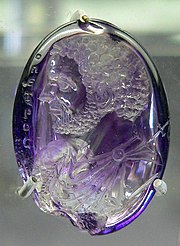Rome

Although jewellery work was abundantly diverse in earlier times, especially among the barbarian tribes such as the Celts, when the Romans conquered most of Europe, jewellery was changed as smaller factions developed the Roman designs. The most common artefact of early Rome was the brooch, which was used to secure clothing together. The Romans used a diverse range of materials for their jewellery from their extensive resources across the continent. Although they used gold, they sometimes used bronze or bone and in earlier times, glass beads & pearl. As early as 2,000 years ago, they imported Sri Lankan sapphires and Indian diamonds and used emeralds and amber in their jewellery. In Roman-ruled England, fossilized wood called jet from Northern England was often carved into pieces of jewellery. The early Italians worked in crude gold and created clasps, necklaces, earrings and bracelets. They also produced larger pendants which could be filled with perfume.
Like the Greeks, often the purpose of Roman jewellery was to ward off the “Evil Eye” given by other people. Although women wore a vast array of jewellery, men often only wore a finger ring. Although they were expected to wear at least one ring, some Roman men wore a ring on every finger, while others wore none. Roman men and women wore rings with a carved stone on it that was used with wax to seal documents, an act that continued into medieval times when kings and noblemen used the same method. After the fall of the Roman Empire, the jewellery designs were absorbed by neighbouring countries and tribes.
Middle Ages


Post-Roman Europe continued to develop jewellery making skills; the Celts and Merovingians in particular are noted for their jewellery, which in terms of quality matched or exceeded that of Byzantium. Clothing fasteners, amulets, and to a lesser extent signet rings are the most common artefacts known to us; a particularly striking celtic example is the Tara Brooch. The Torc was common throughout Europe as a symbol of status and power. By the 8th century, jewelled weaponry was common for men, while other jewellery (with the exception of signet rings) seems to become the domain of women. Grave goods found in a 6th-7th century burial near Chalon-sur-Saône are illustrative; the young girl was buried with: 2 silver fibulae, a necklace (with coins), bracelet, gold earings, a pair of hair-pins, comb, and buckle. The Celts specialized in continuous patterns and designs; while Merovingian designs are best known for stylized animal figures. They were not the only groups known for high quality work; note the Visigoth work shown here, and the numerous decorative objects found at the Anglo-Saxon Ship burial at Sutton Hoo Suffolk, England, are a particularly well-known example. On the continent, cloisonné and garnet were perhaps the quintessential method and gemstone of the period.

The Eastern successor of the Roman Empire, the Byzantine Empire, continued many of the methods of the Romans, though religious themes came to predominate. Unlike the Romans, the Franks, and the Celts, however; Byzantium used light-weight gold leaf rather than solid gold, and more emphasis was placed on stones and gems. As in the West, Byzantine jewellery was worn by wealthier females, with male jewellery apparently restricted to signet rings. Like other contemporary cultures, jewellery was commonly buried with its owner.

No comments:
Post a Comment